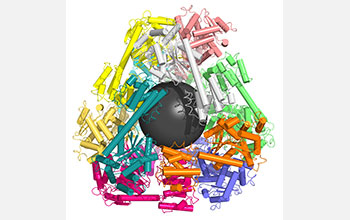Multimedia Gallery
Building molecular 'cages' to fight disease
A molecular cage created by designing specialized protein puzzle pieces. Every color represents a separate protein, where cylindrical segments indicate rigid parts and ribbon-like segments indicate flexible parts of each protein chain. The grey sphere in the protein cage was placed there to indicate the empty space in the middle of the container and is not part of the molecular structure.
More about this image
In 2012, University of California, Los Angeles (UCLA), biochemists designed specialized proteins that assemble themselves to form tiny molecular cages hundreds of times smaller than a single cell. The creation of these miniature structures may be the first step toward developing new methods of drug delivery or even designing artificial vaccines.
"This is the first decisive demonstration of an approach that can be used to combine protein molecules together to create a whole array of nanoscale materials," said Todd Yeates, a professor of chemistry and biochemistry at UCLA.
The research, supported by the National Science Foundation, could be utilized to create cages from any number of different proteins, with potential applications across the fields of medicine and molecular biology.
To learn more about this research, see the UCLA news story Building molecular 'cages' to fight disease. (Date image taken: May 2012; date originally posted to NSF Multimedia Gallery: Dec. 26, 2017)
Credit: Todd Yeates and Yen-Ting Lai/UCLA Chemistry and Biochemistry
Images and other media in the National Science Foundation Multimedia Gallery are available for use in print and electronic material by NSF employees, members of the media, university staff, teachers and the general public. All media in the gallery are intended for personal, educational and nonprofit/non-commercial use only.
Images credited to the National Science Foundation, a federal agency, are in the public domain. The images were created by employees of the United States Government as part of their official duties or prepared by contractors as "works for hire" for NSF. You may freely use NSF-credited images and, at your discretion, credit NSF with a "Courtesy: National Science Foundation" notation.
Additional information about general usage can be found in Conditions.
Also Available:
Download the high-resolution JPG version of the image. (521.2 KB)
Use your mouse to right-click (Mac users may need to Ctrl-click) the link above and choose the option that will save the file or target to your computer.

